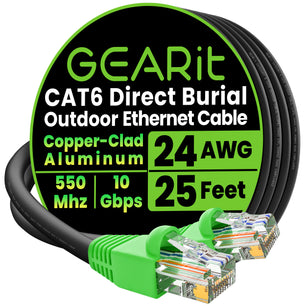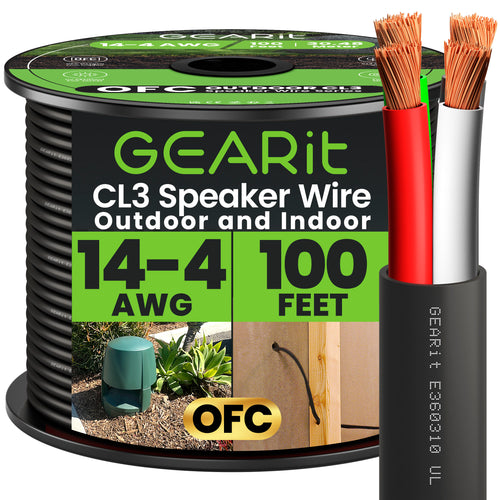A 2-conductor speaker wire is ideal for standard single-speaker connections, while 4-conductor wire is perfect for bi-wiring, bi-amping, or multi-speaker setups, reducing clutter and improving audio flexibility. Choose the right option based on your system’s needs.
Get the perfect speaker wire for your setup with GearIT’s premium 2 and 4-conductor wires:
Shop GearIT now for high-quality wires to elevate your audio experience! 🎶🔌

When setting up a home audio system, choosing the right speaker wire is crucial for sound quality and system functionality. The debate between 2-conductor and 4-conductor speaker wire is one worth understanding for audiophiles and casual listeners alike. This post dives into the distinct differences and advantages of each type.
Understanding 2-Conductor Speaker Wire
-
• Definition and Common Uses:
A 2-conductor speaker wire is the most basic type of speaker cable and is used to connect speakers to an audio source such as an amplifier or receiver. It consists of two separate wires, typically one identified with a marker or color to maintain proper polarity from the speaker to the amplifier. Each wire carries one half of the stereo signal—positive and negative—ensuring that the speaker operates properly. This type of wire is widely used in both home audio systems and car stereo installations due to its straightforward design and function.
-
• Simplicity of Setup:
The primary appeal of 2-conductor wire is its simplicity. With only two points of connection, it's nearly impossible to wire incorrectly. You simply connect the positive terminal on the speaker to the positive terminal on the amplifier and repeat the same for the negative terminals. This ease of use makes it highly accessible for beginners and those who prefer a quick and uncomplicated setup. It’s perfect for a simple stereo setup where advanced configurations such as bi-wiring or bi-amping are not required.
-
• Ideal Scenarios for 2-Conductor Wires:
2-conductor wires are ideal for most standard audio setups, including:
- ○ Basic Home Theaters: For connecting a pair of stereo speakers to an A/V receiver.
- ○ Simple Surround Sound Systems: When running individual wires to each speaker without the need for advanced configurations.
- ○ Car Audio Systems: They are often used in cars where space is limited and the audio system is straightforward.
- ○ Portable Audio Setups: Great for quick, on-the-go installations or temporary setups at events.
- ○ Single Room Audio: When wiring a single room, the simplicity of 2-conductor wires is usually sufficient.
- ○ Budget-Friendly Projects: For individuals looking to set up a sound system without a significant financial investment.
The 2-conductor wire remains the standard choice for most users who want an easy-to-install, reliable, and cost-effective solution for their audio needs. Its universality and simplicity keep it as the go-to option in the vast majority of speaker to amplifier connections.
Understanding 4-Conductor Speaker Wire
-
• Definition and Benefits:
A 4-conductor speaker wire consists of four insulated conductors within a single cable, allowing for more complex wiring setups. This design is beneficial because it can carry two separate stereo signals or enable advanced speaker configurations from a single wire run. The benefits of using a 4-conductor wire include cleaner setup with fewer cables, the potential for better sound quality through bi-amping or bi-wiring, and the convenience of having a single cable that can serve multiple purposes.
-
• Advanced Setup Options like Bi-Wiring and Bi-Amping:
Bi-wiring and bi-amping are two advanced setups that can potentially improve sound quality, and both are facilitated by 4-conductor speaker wires:
-
○ Bi-Wiring: This involves using two pairs of wires from the same amplifier to separately connect to the high frequency and low frequency terminals on a speaker. Proponents believe that bi-wiring can reduce the magnetic interference and improve sound clarity since the high and low frequencies are handled by separate conductors.
-
○ Bi-Amping: Bi-amping takes advantage of the 4-conductor wire by connecting two pairs of conductors to two separate amplifiers—one dedicated to the treble and the other to the bass. This allows for more precise control over the amplification process, which can result in clearer, more dynamic sound.
-
Both these methods are said to enhance the listening experience by ensuring that the audio signal is cleanly and efficiently delivered to the speakers.
-
• Multi-Room Audio Systems and Future-Proofing Your Setup:
For multi-room audio setups, 4-conductor speaker wires offer a streamlined solution. With a single cable, you can run two stereo signals to different zones, which is perfect for sending audio from a centralized amplifier to speakers in various rooms.
Additionally, when you wire your home with 4-conductor cables, you are future-proofing your audio setup. Even if you do not require bi-wiring or bi-amping capabilities now, should you choose to upgrade your system later, the appropriate cabling will already be in place. This saves on the cost and hassle of re-wiring and supports higher-end audio applications as your system grows or evolves.
Practical Advice for Users
When navigating the choices between speaker wires, it’s important to match the wire to the application for the best results. Here’s a deeper look into the practical advice for users when choosing between 2-conductor and 4-conductor wires:
When to Choose 2-Conductor Wire:
- • Stereo Setups: If you have a simple stereo setup, such as two speakers and an amplifier, 2-conductor wire is more than adequate.
- • Cost-Effectiveness: When budget constraints are a factor, 2-conductor wire is typically less expensive and still provides good quality sound.
- • Ease of Handling: If you prefer ease of use and simplicity in installation, 2-conductor wires are less cumbersome and easier to manage.
- • Space Considerations: In tight spaces, like car audio installations or small home theaters, 2-conductor wires are easier to route and take up less space.
Scenarios Where 4-Conductor Wire is Beneficial:
- • Bi-Amping/Bi-Wiring: If your speakers and amplifiers support bi-amping or bi-wiring, a 4-conductor wire is essential for splitting the signal effectively.
- • Multi-Room Audio Systems: For setups that distribute audio to multiple rooms from a central location, 4-conductor wire can efficiently carry multiple channels.
- • Advanced Home Theaters: If you're building a sophisticated home theater that may include Atmos setups or other advanced features, 4-conductor wires provide the flexibility for future upgrades.
- • Outdoor Speaker Systems: When wiring for outdoor speakers, a 4-conductor wire allows for a single, durable cable run, which is especially useful for speakers placed at a distance from the audio source.
Tips on Installation and Maximizing Audio Quality:
- • Correct Polarity: Always ensure that the polarity (+/-) is consistently matched from the amplifier to the speakers to prevent phase issues.
- • Proper Gauge: Choose the correct gauge (thickness) of wire for the distance of the run. Longer runs require thicker wires to prevent signal loss.
- • Quality Connectors: Use high-quality connectors such as banana plugs, spade connectors, or bare wire to ensure a solid connection with minimal signal degradation.
- • Avoiding Interference: Keep speaker wires away from power cables to prevent electrical interference. Also, consider using twisted pair designs that can reduce noise.
- • Cable Management: Use cable ties or conduits to keep wires organized, which not only looks neat but also prevents tangling and reduces the chance of damage.
- • Environmental Considerations: For outdoor or in-wall installations, make sure the wire is rated for the environment (e.g., UL-rated for in-wall use, weatherproof for outdoor use) to ensure safety and longevity.
Both 2-conductor and 4-conductor speaker wires have their place in audio system setups. Understanding your current needs and future plans can guide you to the right choice, ensuring that your audio experience is as rich and high-fidelity as possible.
Are you ready to upgrade your audio experience? Check out our collection here and tell us about your speaker wire choices!


























































